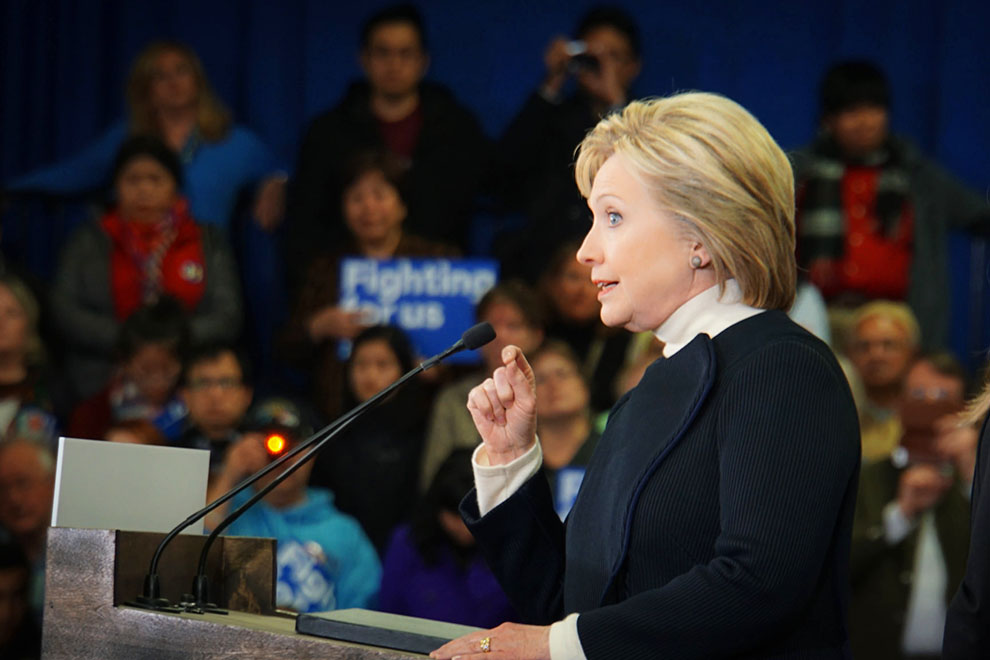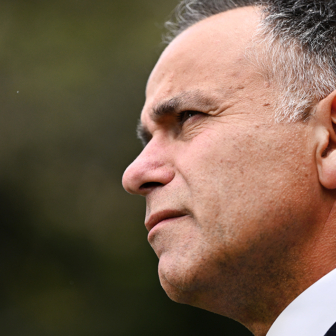Tuesday 9 February was a cold, snowy day in New Hampshire, but that didn’t deter record numbers of citizens turning out to vote in the 2016 presidential primaries. Their votes reinforced the momentum for socialist senator Bernie Sanders and bellicose businessman Donald Trump, showing for some weeks in the polls, and yet delivered little clarity on the future political fortunes of the candidates who remain in the race for president.
Just twenty minutes after the polls closed, the major television stations were declaring victory for Sanders against Hillary Clinton and Trump against his eight Republican rivals. But the also-rans got to put their own spin on the evening’s results and the ongoing complications of this tortured primary season were soon apparent.
The Democratic primary is now down to two candidates, and while it was always predicted that Sanders would beat Clinton in New Hampshire no one foresaw that he would do this by more than twenty points. Clinton nevertheless gave a rousing and effective concession speech to her campaign troops that belied her substantial loss in a state she won handsomely in 2008, and it can be argued that she has every right to feel that the future is still hers to seize. As the campaign moves into states with more diverse populations, support from African Americans and Hispanics will boost her polling; and she has the endorsements, the financing and the organisation to carry her through. But her campaign staff are seriously worried and it is clear that they are wrestling with how to manage the conundrum that is Bernie Sanders.
Among the people of New Hampshire who voted in the Democrat primaries, Sanders won 83 per cent of voters under the age of 30, highlighting his appeal to young people. He won 73 per cent of self-described independents and 67 per cent of people who described themselves as very liberal. He also took 55 per cent of Democrat women’s votes. It’s not clear if this simply reflects his overwhelming winning margin or if women (especially young women) are turning away from Clinton. Perhaps the most telling numbers are those that show he was the overwhelming favourite of voters who were looking for a candidate they see as honest and trustworthy (92 per cent) and caring about people like them (82 per cent).
These numbers highlight the problem facing Clinton: her message is in urgent need of renovation. She has admirable policies and processes for implementing them, but has been unable to project a vision. Her pragmatic approach, and the incrementalism that necessarily accompanies it, are of little appeal to voters who are angry about current politics and who favour integrity and authenticity over electability. Sanders, on the other hand, has tapped into the move to the left among Democrats – thus claiming the title of progressive at Clinton’s expense – and has been so bold as to capitalise on the progressives’ disappointment in President Obama. It is intriguing that a seventy-three-year-old man has been able so effectively to galvanise young people, and even the young women who might be expected to support the possibility of the nation’s first woman president.
Ironically, many of these same issues – an angry electorate, voters who feel betrayed by Washington and look to reject the establishment – helped fuel Donald Trump’s win in the primary. In their own very different ways, Trump and Sanders have exposed the injuries of socioeconomic divides in today’s America. In both Sanders and Trump, the people of New Hampshire have chosen candidates whose policies and pronouncements are effectively unimplementable, and who are the least likely of all the candidates to make Washington work better than it does currently. Yet that is of little concern to these voters. They don’t want more insiders like Clinton and Bush, they want a true outsider.
Even Trump’s ugly and xenophobic pronouncements brought him success in New Hampshire. Polls found that 68 per cent of Republican voters in the primaries supported his proposed ban on Muslims coming to the United States, and this figure rose to 82 per cent among Republican voters.
Trump’s continued, even growing, viability is helped by the infighting between the Republican candidates and the fact that with so many still in the race, he can continue to win with only 34 per cent of the vote. Candidates like Jeb Bush, John Kasich and Marco Rubio currently split a more moderate conservative vote that could be enough to defeat Trump and/or Ted Cruz. This situation is little eased by Chris Christie and Carly Fiorina leaving the race, although it will be interesting to see where their support (voters and donors) direct their attention. Of those who remain (Bush, Cruz, Rubio, Kasich and Ben Carson), all but Kasich have significant campaign funds, although only Bush appears to have a fully implemented campaign organisation.
Ahead are unknowns on all sides. The primaries in South Carolina and the caucuses in Nevada are both split, requiring candidates to divide their time between the two states. In South Carolina, Republicans will vote on 20 February and Democrats on 27 February. The Nevada caucuses for Democrats are also on 20 February and those for Republicans are three days later.
To date there has been little polling in these states; the most recent Real Clear Politics aggregate of polls taken in South Carolina in January has Clinton ahead of Sanders by 29.5 percentage points and Trump well ahead of his rivals. There have been no new polls in Nevada since the end of 2015, and further public polling seems unlikely because pollsters believe it is hard to get accurate results in this state. The competition between Sanders and Clinton, as exemplified by their 4 February debate, is increasingly fierce. Importantly, Sanders has the money to ensure that his candidacy doesn’t falter in the weeks ahead. He has relied on very successful grassroots donations and eschewed political action committees, or PACs, to build what has been described as a fundraising juggernaut. Open Secrets puts the total figure at US$75.3 million. Clinton, who accepts PAC money, has amassed a campaign fund estimated by Open Secrets to be $163.6 million.
Both of these candidates must now make gains with new constituencies. In just the last few days Sanders has reached out to African-American leaders such as Al Sharpton, looking for the boost their endorsements would bring. Clinton has admitted she must do more to reach young voters.
Decisive wins in South Carolina and Nevada are essential for Clinton, not because of the number of delegates involved but because of the impact a loss will have on public perceptions of her candidacy and perhaps even on the morale of the Democrat leaders. There are those who see Sanders’s emergence as a presidential candidate as suicide for the party, in the same way that Trump and Cruz are seen as destructive for the future of the GOP.
On the Republican side, it’s hard to see what or who can stop the Trump steamroller. Cruz is trying to present South Carolina as a two-man race between himself and Trump, but the fact is that Rubio, Bush and Kasich must all be considered competition – at least for Cruz. The next few weeks will be make or break for these men, although we have already seen how a close or surprising second, third and even fourth place can boost a candidate’s chances.
Money – and how it’s spent – will be important. Bloomberg News reports that the Republican candidates and the groups supporting them have already poured an estimated $24 million into political advertisements in South Carolina, nearly triple the amount spent in 2012. Almost half of that ($11.6 million) has come from super PACS backing Bush, and $6.9 million has been spent on Rubio’s behalf.
Both the Republican and Democrat party leaders will be perturbed to see that independents’ votes helped fuel Trump’s most recent poll win and there will be a concerted effort to win over this group. Only some states have open primaries that do not require voters to be affiliated with a political party in order to vote for partisan candidates; South Carolina is one of these. A growing number of registered American voters (about 41 per cent) call themselves independent, a much higher percentage than either political party can claim.
It’s early days yet in the primary campaign. By the end of this month just a handful of delegates will have been assigned. Despite the angst, Clinton will leave New Hampshire with the same number of delegates as Sanders because she had previously locked in the support of six super delegates. And Trump should remember that McCain left New Hampshire a winner in 2008. But early victories set the tone for what is to come and boost fundraising, campaign organisation and media attention.
The obvious cautionary note is that this is a very atypical election cycle and likely not one in which the rubrics of the past will hold. The possibility looms that the pundits may have to adjust their rhetoric. I am not the only observer who has repeatedly written that an establishment Republican candidate will eventually emerge to knock Trump aside, and that Clinton is such a standout candidate she will easily win the Democrat nomination and then go on to win the general election.
Let’s see what Super Duper Tuesday on 1 March brings, and where the 565 bound delegates allocated in those primaries and caucuses go. Then there will be a real basis on which to change predictions and rhetoric. •




